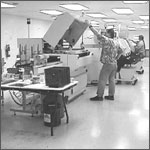Printing Industry eTool
Ergonomics in the Printing Industry
Workers involved in printing processes may be at risk of developing musculoskeletal disorders (MSDs) from workplace activities which force them to work outside their physical capacities (i.e., lifting an item that is too heavy, or lifting too often, or working in awkward body postures). MSDs are a serious problem as they can increase the number of employee lost work days, increase insurance costs, increase training and staffing costs, and reduce operation efficiency and quality. Changes which allow employees to work within their physical limits reduce the number errors, sick days, and injuries and enable employees to be more productive and produce a higher quality product. Ergonomic improvements are often simple and obvious, but even if they require significant effort they generally justify the resources spent. Good ergonomics is good business.
This eTool was developed as part of the OSHA and Graphics Arts Coalition Alliance. This eTool* provides information based on the experience of others with the hope of making the process of hazard minimization easier. This eTool is divided into the following process pages that correspond to the major styles of printing: Lithography, Flexography, and Screen Printing.
Within each process page the user will find a description of the printing process and the trouble areas that have currently been identified for that process. The user can navigate between each area to become familiar with the hazard and to see what others have identified as possible solutions allowing an employer or employee to address these problems.
See OSHA's Workers' Rights page for more information on rights and protections.
*eTools are "stand-alone", interactive, Web-based training tools specializing in occupational safety and health topics. They utilize graphical menus and as indicated in the disclaimer, do not create new OSHA requirements.




